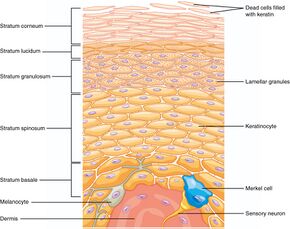Biology:Merkel cell
| Merkel cell | |
|---|---|
 Merkel cells (shown in blue) are located in the basal epidermal layer of the skin. | |
| Details | |
| Location | Skin of vertebrates |
| Function | Light touch sensation |
| Anatomical terms of neuroanatomy | |
Merkel cells, also known as Merkel-Ranvier cells or tactile epithelial cells, are oval-shaped mechanoreceptors essential for light touch sensation and found in the skin of vertebrates. They are abundant in highly sensitive skin like that of the fingertips in humans, and make synaptic contacts with somatosensory afferent nerve fibers. It has been reported that Merkel cells are derived from neural crest cells, though more recent experiments in mammals have indicated that they are epithelial in origin.
Structure
Merkel cells are found in the skin and some parts of the mucosa of all vertebrates. In mammalian skin, they are clear cells found in the stratum basale[1][2] (at the bottom of sweat duct ridges) of the epidermis approximately 10 μm in diameter. They are oval-shaped mechanoreceptors essential for light touch sensation and found in the skin of vertebrates. They are abundant in highly sensitive skin like that of the fingertips in humans, and make synaptic contacts with somatosensory afferent nerve fibers.[3] They also occur in epidermal invaginations of the plantar foot surface called rete ridges.[4]
Most often, they are associated with sensory nerve endings, when they are known as Merkel nerve endings (also called a Merkel cell-neurite complex). They are associated with slowly adapting (SA1) somatosensory nerve fibers. They react to low vibrations (5–15 Hz) and deep static touch such as shapes and edges. Due to a small receptive field (extremely detailed info) they are densely present in areas like fingertips; they are not covered (shelled) and thus respond to pressures over long periods.
Developmental
The origin of Merkel cells has been debated for over 20 years. Evidence from skin graft experiments in birds implies that they are neural crest derived,[5] but experiments in mammals now demonstrate an epidermal origin.[6][7]
Function
The German anatomist Friedrich Sigmund Merkel referred to Merkel cells as Tastzellen or "touch cells". Until recently this proposed function was controversial and hard to prove, due the close physical association of Merkel cells with sensory nerve endings. However, recent work in mice and other model organisms demonstrates that Merkel cells intrinsically transform touch into electrical signals that are transmitted to the nervous system.[8] Merkel cells express PIEZO2, a mechanosensitive ion channel that responds to mechanical forces. Mice in which Piezo2 is knocked-out specifically in skin cells, but not sensory neurons, show decreased behavioral responses to gentle touch.[9]
Merkel cells are sometimes considered APUD cells (an older definition, more commonly classified as a part of dispersed neuroendocrine system) because they contain dense core granules, and thus may also have a neuroendocrine function.[10]
Susceptibility to malignancy
Although uncommon, these cells may become malignant and form a Merkel cell carcinoma—an aggressive and difficult to treat skin cancer.[11][12]
See also
- Merkel nerve ending
- Merkel cell carcinoma
- List of keratins expressed in the human integumentary system
- List of human cell types derived from the germ layers
- List of distinct cell types in the adult human body
References
- ↑ "6.02 - Merkel Cells" (in en). The Senses: A Comprehensive Reference. New York: Academic Press. January 2008. pp. 33–38. doi:10.1016/b978-012370880-9.00341-8. ISBN 978-0-12-370880-9.
- ↑ "Anatomy, Physiology, Histology, and Immunohistochemistry of Human Skin" (in en). Skin Tissue Engineering and Regenerative Medicine. Academic Press. January 2016. pp. 1–17. doi:10.1016/b978-0-12-801654-1.00001-2. ISBN 978-0-12-801654-1.
- ↑ Mescher, Anthony L (2016). Junqueira's Basic Histology. McGraw-Hill Education. ISBN 978-0-07-184270-9.
- ↑ "Friedrich Sigmund Merkel and his "Merkel cell", morphology, development, and physiology: review and new results". The Anatomical Record Part A: Discoveries in Molecular, Cellular, and Evolutionary Biology 271 (1): 225–239. March 2003. doi:10.1002/ar.a.10029. PMID 12552639.[|permanent dead link|dead link}}]
- ↑ The Merkel cell: structure-development-function- cancerogenesis. Springer. 2003. pp. 99–. ISBN 978-3-540-00374-8. https://archive.org/details/springer_10.1007-978-3-662-10358-6. Retrieved 2 May 2010.
- ↑ "Mammalian Merkel cells are descended from the epidermal lineage". Developmental Biology 336 (1): 76–83. December 2009. doi:10.1016/j.ydbio.2009.09.032. PMID 19782676.
- ↑ "Epidermal progenitors give rise to Merkel cells during embryonic development and adult homeostasis". The Journal of Cell Biology 187 (1): 91–100. October 2009. doi:10.1083/jcb.200907080. PMID 19786578.
- ↑ "Epidermal Merkel cells are mechanosensory cells that tune mammalian touch receptors". Nature 509 (7502): 617–621. May 2014. doi:10.1038/nature13250. PMID 24717432. Bibcode: 2014Natur.509..617M.
- ↑ "Piezo2 is required for Merkel-cell mechanotransduction". Nature 509 (7502): 622–626. May 2014. doi:10.1038/nature13251. PMID 24717433. Bibcode: 2014Natur.509..622W.
- ↑ "Skin: Basic Structure and Function". Pathobiology of Human Disease. San Diego: Academic Press. January 2014. pp. 1134–1144. doi:10.1016/b978-0-12-386456-7.03501-2. ISBN 978-0-12-386457-4.
- ↑ "Merkel Cell Carcinomas Arising in Autoimmune Disease Affected Patients Treated with Biologic Drugs, Including Anti-TNF". Clinical Cancer Research 23 (14): 3929–3934. July 2017. doi:10.1158/1078-0432.CCR-16-2899. PMID 28174236.
- ↑ "Pathophysiology of merkel cell". Journal of Oral and Maxillofacial Pathology 17 (3): 408–412. September 2013. doi:10.4103/0973-029x.125208. PMID 24574661.
External links
- Merkel Cells at the US National Library of Medicine Medical Subject Headings (MeSH)
- NIF Search - Merckel Disc Cell via the Neuroscience Information Framework
 |


